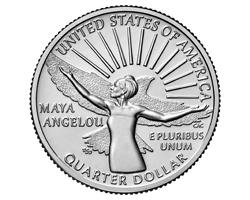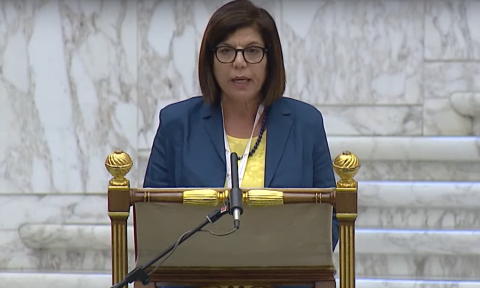
Photo by US MINT
A U.S. Mint four-year program celebrates the accomplishments and contributions made by women to the development and history of the country.
The first to be depicted has been Maya Angelou (1928–2014), the celebrated African American writer, performer and social activist. Her right profile has been featured in quarters issued by the U.S. Mint at the end of January. The coin depicts a youthful Angelou with her arms outstretched, beams of sunlight haloing her. Her gesture is mirrored by the silhouette of a bird in flight behind her, which is a reference to Angelou’s widely read coming-of-age memoir I Know Why the Caged Bird Sings from 1969.
Maya has become the first Black woman to appear on a U.S. quarter. She opened a pathway for other American women who played important roles in the country’s history, and that will see their effigy minted on coins.
In fact, the U.S. Mint plans to issue 20 more quarters over the next four years to celebrate women’s accomplishments and contributions from a variety of fields, including suffrage, civil rights, abolition, government, humanities, science, space and the arts. Women honored by the program American Women Quarters will be from ethnically, racially and geographically diverse backgrounds.
Beginning in 2022, and continuing through 2025, the U.S. Mint will issue up to five new reverse designs each year, while the obverse (heads) will depict a portrait of George Washington, originally composed and sculpted by Laura Gardin Fraser to mark George Washington’s 200th birthday.
Ultimately, then-Treasury secretary Mellon selected the familiar left-facing John Flannigan design. However, the Mint wants to do justice to Laura too who, in 1921, designed the Alabama centennial half dollar, becoming the first woman to draw a U.S. coin.
After Maya Angelou, the next distinguished American woman celebrated in the 2022 quarters will be Dr. Sally Ride (1951–2012), a physicist, astronaut, educator and the first American woman in space.
Next on the list is Wilma Mankiller (1945–2010), the first female to be elected principal chief of the Cherokee Nation.
Toward the end of the year, it will be Nina Otero-Warren’s turn (1881–1965). She was a leader in New Mexico’s suffrage movement and the first female superintendent of Santa Fe public schools.
Anna May Wong (1905–1961), the first Chinese American film star in Hollywood, will close the first-year program.
The honorees have been selected through a consultation issued by the Secretary of the Treasury with the Smithsonian Institution’s American Women’s History Initiative, the National Women’s History Museum and the Congressional bipartisan women’s caucus. In 2021, the public was invited to submit recommendations for potential honorees through a web portal established by the National Women’s History Museum.
Historical women have rarely featured on U.S. currency. In the 19th century, First Lady Martha Washington was on the one-dollar silver certificate, and the Native American heroine Pocahontas was in a group picture on the $20 bill.
On coins, Sacagawea, the Native American explorer, was depicted on the gold dollar. Suffragist Susan B Anthony and deaf-blind activist Helen Keller appeared on the silver dollar and on the Alabama quarter respectively.
Instead, political controversy has pushed back the replacement of the seventh U.S. President Andrew Jackson by escaped slave and abolitionist Harriet Tubman on the $20 bill, until at least 2026.
Meanwhile, check your coins in case you find yourself holding a Maya Angelou quarter, which may evoke the memory of her famous words, “Be certain that you do not die without having done something wonderful for humanity.”












